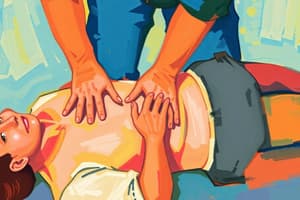Podcast
Questions and Answers
What is the abdominal-thrust maneuver also called?
What is the abdominal-thrust maneuver also called?
- Heimlich maneuver (correct)
- CPR
- ALS
- BLS
What does active compression-decompression CPR involve?
What does active compression-decompression CPR involve?
Compressing the chest and then actively pulling it back to its neutral position or beyond.
What are advanced life support (ALS) procedures used for?
What are advanced life support (ALS) procedures used for?
Treating medical conditions such as cardiac monitoring and administering intravenous fluids.
What is basic life support (BLS)?
What is basic life support (BLS)?
What does CPR stand for?
What does CPR stand for?
What is chest compression fraction?
What is chest compression fraction?
What is dependent lividity?
What is dependent lividity?
What is gastric distension?
What is gastric distension?
What is the head tilt-chin lift maneuver used for?
What is the head tilt-chin lift maneuver used for?
What signifies hyperventilation?
What signifies hyperventilation?
What is the jaw-thrust maneuver?
What is the jaw-thrust maneuver?
What is the recovery position?
What is the recovery position?
What does ROSC stand for?
What does ROSC stand for?
What is rigor mortis?
What is rigor mortis?
What is stridor?
What is stridor?
What is ventilation?
What is ventilation?
What is the normal pulse rate for an adult?
What is the normal pulse rate for an adult?
What is the normal pulse rate for a newborn?
What is the normal pulse rate for a newborn?
What is the normal respiratory rate for a child aged 1-5 years?
What is the normal respiratory rate for a child aged 1-5 years?
What flow rate does a nasal cannula typically provide?
What flow rate does a nasal cannula typically provide?
What is considered tachycardia?
What is considered tachycardia?
What is considered bradycardia?
What is considered bradycardia?
Where is the radial pulse felt?
Where is the radial pulse felt?
Where is the brachial pulse felt?
Where is the brachial pulse felt?
Where is the carotid pulse felt?
Where is the carotid pulse felt?
What does respiration refer to?
What does respiration refer to?
What does respiratory quality assess?
What does respiratory quality assess?
What is the systolic blood pressure?
What is the systolic blood pressure?
What is diastolic blood pressure?
What is diastolic blood pressure?
What is a sphygmomanometer?
What is a sphygmomanometer?
According to the 2020 AHA Guidelines, what is the preferred ventilatory rate for an adult arrest patient with an advanced airway?
According to the 2020 AHA Guidelines, what is the preferred ventilatory rate for an adult arrest patient with an advanced airway?
What finding suggests chest compressions should be continued in a newborn?
What finding suggests chest compressions should be continued in a newborn?
Why is it important to confirm pulselessness before applying an AED?
Why is it important to confirm pulselessness before applying an AED?
What should be done after successfully resuscitating an adult who is not breathing?
What should be done after successfully resuscitating an adult who is not breathing?
What is the next step after turning on an AED and attaching electrodes?
What is the next step after turning on an AED and attaching electrodes?
What is key to successful defibrillation after an underwater event?
What is key to successful defibrillation after an underwater event?
What historical information is crucial to pass on for a confused patient?
What historical information is crucial to pass on for a confused patient?
What should EMS providers obtain during initial training?
What should EMS providers obtain during initial training?
What should rescuers do if paramedics are delayed during a prolonged resuscitation?
What should rescuers do if paramedics are delayed during a prolonged resuscitation?
What is the most valuable reason for having paramedics assist with a cardiac call?
What is the most valuable reason for having paramedics assist with a cardiac call?
What spinal precautions should be taken for a patient with a suspected spinal injury?
What spinal precautions should be taken for a patient with a suspected spinal injury?
How can compressions be improved while CPR is performed on a pregnant patient?
How can compressions be improved while CPR is performed on a pregnant patient?
What is the correct compression rate for a newborn who is apneic and pulseless?
What is the correct compression rate for a newborn who is apneic and pulseless?
What should be done after removing a potential adult drowning victim from water?
What should be done after removing a potential adult drowning victim from water?
What steps should be modified if alone treating an unresponsive and apneic adult?
What steps should be modified if alone treating an unresponsive and apneic adult?
What should be administered FIRST to an unresponsive neonate with a clear airway?
What should be administered FIRST to an unresponsive neonate with a clear airway?
What is an unnecessary distraction with an AED?
What is an unnecessary distraction with an AED?
Why is maintenance of an AED so important?
Why is maintenance of an AED so important?
How can agencies minimize challenges with AED battery failure?
How can agencies minimize challenges with AED battery failure?
Why do self-adhesive pads improve AED defibrillation performance?
Why do self-adhesive pads improve AED defibrillation performance?
What is the most valuable reason for completing an AED checklist at the beginning of a shift?
What is the most valuable reason for completing an AED checklist at the beginning of a shift?
Why should medical direction review cardiac arrest calls involving an AED?
Why should medical direction review cardiac arrest calls involving an AED?
Flashcards are hidden until you start studying
Study Notes
BLS Resuscitation Terms and Definitions
- Abdominal-thrust maneuver: Dislodges severe airway obstruction in adults and children; commonly known as the Heimlich maneuver.
- Active compression-decompression CPR: Involves compressing the chest and actively pulling it back to its neutral position.
- Advanced life support (ALS): Involves advanced lifesaving procedures; includes cardiac monitoring and administration of intravenous fluids and medications.
- Basic life support (BLS): Noninvasive emergency care for airway obstruction, respiratory arrest, and cardiac arrest.
- Cardiopulmonary resuscitation (CPR): Combines chest compressions and rescue breathing to establish ventilation and circulation in patients without pulse and breathing.
Key Processes in Resuscitation
- Chest compression fraction: Percentage of time during a resuscitation that active chest compressions are performed.
- Dependent lividity: Blood pooling in the lowest parts of the body, indicating death.
- Gastric distension: Air filling the stomach due to high volume and pressure during ventilation.
- Head tilt-chin lift maneuver: Opens the airway by tilting the forehead and lifting the chin; not recommended for trauma patients.
- Jaw-thrust maneuver: Opens the airway by moving the jaw forward; used for potential cervical spine injury.
Airway Management
- Recovery position: Side-lying position for unresponsive patients, ensuring a clear airway.
- Return or spontaneous circulation (ROSC): Resumption of pulse and effective blood flow in previously cardiac arrest patients.
- Rigormortis: Muscle stiffening post-death; a definitive sign.
- Stridor: High-pitched sound during inspiration indicating upper airway obstruction.
Vital Signs and Normal Ranges
- Adult normal pulse: 60 to 100 beats per minute.
- Adult normal respirations: 12 to 20 breaths per minute.
- Newborn normal pulse: 90-180 beats per minute.
- Newborn normal respirations: 30 to 60 breaths per minute.
- Infant normal pulse: 100-160 beats per minute.
- Infant normal respirations: 25 to 50 breaths per minute.
- Toddler normal pulse: 90-150 beats per minute.
- Toddler normal respirations: 20 to 30 breaths per minute.
Oxygen Delivery Methods
- Nasal cannula flow rate: 1-6 liters/minute; delivers 24-44% oxygen.
- Non-rebreathing mask: 10-15 liters/minute; provides nearly 95% oxygen.
- Bag-valve-mask (BVM): 15 liters/minute; supplies nearly 100% oxygen.
Cardiac Rhythm Insights
- Tachycardia: Rapid heartbeat exceeding 100 beats per minute.
- Bradycardia: Slow heartbeat below 60 beats per minute.
Pulse Locations
- Radial pulse: Felt at the wrist.
- Brachial pulse: Located in the upper arm (for children).
- Carotid pulse: Palpated in the neck.
Respiratory Mechanics
- Respiration: Process of inhalation and exhalation.
- Respiratory quality: Assessment of breathing character (e.g., shallow, labored).
- Respiratory rhythm: Regularity or irregularity of breaths.
Blood Pressure Understanding
- Systolic blood pressure: Pressure during heart contraction.
- Diastolic blood pressure: Pressure when the heart is relaxed.
CPR and AED Procedures
- Preferred ventilatory rate for advanced airway in adult: 1 breath every 5 to 6 seconds.
- Chest compressions for newborns: Continue if pulse is below 60.
- AED usage before application: Confirm patient is pulseless and apneic; AEDs cannot detect pulselessness.
- Post-resuscitation for unresponsive adult: Initiate BVM at 10 breaths per minute, targeting SaO2 of 92-98%.
Rescuer Protocol and Techniques
- Spinal injury precautions: Initiate manual spinal motion restriction for suspected spine injuries.
- Effective compressions during pregnancy: Manually displace the fundus to the left.
- Compression rate for newborn: 120 per minute.
Patient Assessment and Communication
- Key information to share during transport: Patients taking coumadin (blood thinner) require special attention.
- AED inspection and maintenance: Regularly check batteries and equipment to ensure functionality.
Quality Improvement and Analysis
- AED checklist at shift start: Conducting an inventory and inspection of equipment is essential.
- Quality improvement reviews: Essential for trend analysis on AED use to enhance response strategies.
Studying That Suits You
Use AI to generate personalized quizzes and flashcards to suit your learning preferences.





